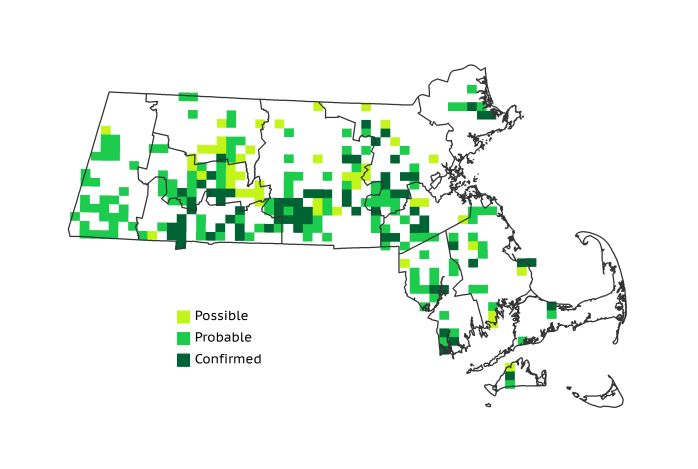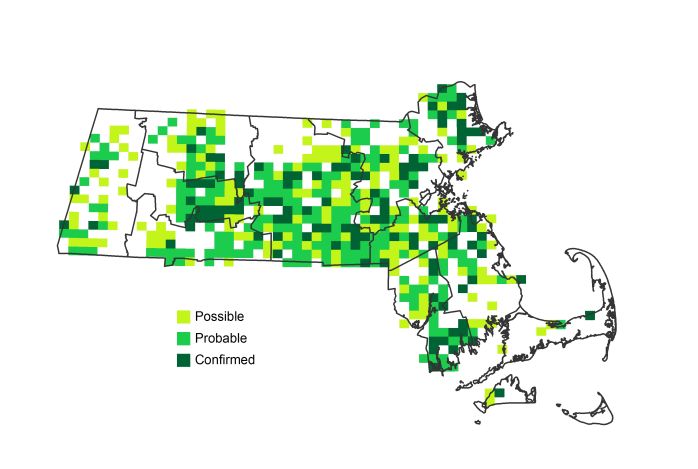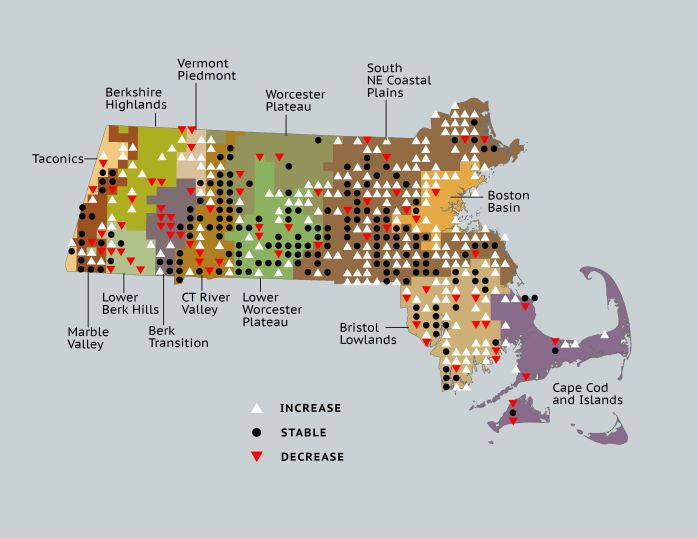Find a Bird
Blue-winged Warbler
Vermivora cyanoptera

Fairly widespread and likely increasing
State Wildlife Action Plan listed
“Despite their name, which would seem to imply musical ability of no mean order, our wood warblers, with few exceptions, occupy no very high place in the musical galaxy.” – Henry W. Henshaw, The Book of Birds: Common Birds of Town and Country and American Game Birds
In spring, a walk through scrubby habitat near the edge of a forest will often reward you with the insect-like call of the male Blue-winged Warbler. Today a rather common sight in many places, the Blue-winged Warbler is something of a newcomer to the ranks of Massachusetts’ breeding birds. Although it has generally been regarded as a welcome addition to the Commonwealth’s avifauna, its role in displacing the closely related Golden-winged Warbler has been a bit of a black mark on this species’ reputation.
Historic Status
Dedham was the first site in Massachusetts to have a connection with the Blue-winged Warbler, when a “small flock” of them was found there during migration in 1857 (Howe & Allen 1901). A single bird was later taken in 1878 in West Roxbury, and another seen in Dorchester in 1897 (Howe & Allen 1901), but the first nest in Massachusetts was not reported until Horace W. Wright noted his discovery of one in Sudbury in May 1909. Just four years later, hybrid offspring of Blue-winged and Golden-winged Warblers appeared in Lexington. In 1923, another nest was discovered in Brockton (Forbush 1929). Although the Blue-winged Warbler was still considered a rarity in Massachusetts, even by that time its northward range expansion along the eastern seaboard was well underway. By the mid-1950s, it had established breeding grounds from the Connecticut River Valley eastward, and soon moved west as well.
Atlas 1 Distribution
By the time of Atlas 1 Blue-winged Warblers were in the midst of widespread colonization of the Commonwealth, and were found in 27% of the blocks surveyed. In western Massachusetts, they were present in small numbers in most regions, but they were most commonly encountered where they could move into the state from the south along river valleys, particularly in the Mable Valleys, Lower Berkshire Hills, and Berkshire Transition zones. The Connecticut River Valley, offering edge habitat and overgrown pastures galore, had 55% block occupancy. Close to 20% of the Worcester Plateau was occupied, but the Lower Worcester Plateau boasted more than twice that number, likely thanks to its more southerly position and lower elevation. Blue-winged Warblers peppered the landscape across the Coastal Plains and Bristol/Narragansett Lowlands, but neither the Boston Basin nor the Cape and Islands regions supported more than 10 occupied blocks apiece.
Atlas 2 Distribution and Change
As its close cousin the Golden-winged Warbler diminished to the point of extirpation, the Blue-winged Warbler swiftly claimed much of Massachusetts for its own during the Atlas interval, with block occupancy rising to 48% statewide. The picture in the westernmost regions was somewhat chaotic, with little stability and many small net gains or losses as the species tracked its preferred shrub-edge habitat across the landscape. In central Massachusetts, the trend was decidedly positive, with modest but notable gains in the Connecticut River Valley and both Worcester Plateau regions. The Coastal Plains experienced the largest expansion of Blue-winged Warblers in the state, both in overall number of new blocks (94) and in the effort-controlled percent of the region newly occupied (36%). The Boston Basin and Bristol/Narragansett Lowlands also exhibited notable growth in the distribution of Blue-winged Warblers. The Cape Cod and Islands ecoregion was characterized mostly by low stability and lots of movement, with a slight trend toward increased occupancy.
Atlas 1 Map

Atlas 2 Map

Atlas Change Map

Ecoregion Data
Atlas 1 | Atlas 2 | Change | ||||||
Ecoregion | # Blocks | % Blocks | % of Range | # Blocks | % Blocks | % of Range | Change in # Blocks | Change in % Blocks |
Taconic Mountains | 4 | 25.0 | 1.5 | 7 | 28.0 | 1.4 | 1 | 6.7 |
Marble Valleys/Housatonic Valley | 17 | 43.6 | 6.6 | 21 | 53.8 | 4.2 | 4 | 10.3 |
Berkshire Highlands | 4 | 7.3 | 1.5 | 10 | 18.2 | 2.0 | 6 | 11.3 |
Lower Berkshire Hills | 11 | 39.3 | 4.2 | 7 | 22.6 | 1.4 | -3 | -11.1 |
Vermont Piedmont | 3 | 17.6 | 1.2 | 12 | 70.6 | 2.4 | 4 | 33.3 |
Berkshire Transition | 16 | 42.1 | 6.2 | 14 | 35.0 | 2.8 | -5 | -16.1 |
Connecticut River Valley | 31 | 55.4 | 12.0 | 46 | 70.8 | 9.3 | 7 | 14.6 |
Worcester Plateau | 15 | 19.2 | 5.8 | 31 | 35.2 | 6.3 | 6 | 12.5 |
Lower Worcester Plateau | 33 | 44.6 | 12.7 | 58 | 72.5 | 11.7 | 9 | 16.7 |
S. New England Coastal Plains and Hills | 80 | 29.6 | 30.9 | 192 | 67.8 | 38.7 | 82 | 36.3 |
Boston Basin | 4 | 7.1 | 1.5 | 22 | 39.3 | 4.4 | 18 | 32.7 |
Bristol and Narragansett Lowlands | 32 | 30.2 | 12.4 | 61 | 53.5 | 12.3 | 24 | 23.8 |
Cape Cod and Islands | 9 | 6.6 | 3.5 | 15 | 10.4 | 3.0 | 3 | 2.5 |
Statewide Total | 259 | 26.7 | 100.0 | 496 | 47.8 | 100.0 | 156 | 18.8 |
Notes
The Blue-winged Warbler shows a significant decreasing Breeding Bird Survey (BBS) trend in Massachusetts and in the New England Mid-Atlantic Region. The decline noted in the BBS is of interest because it is at odds with the Massachusetts BBA2 results. Though they remain widespread, Blue-winged Warblers are less numerous, and fall into our “whispering bird” category – those with a demonstrated stable or increasing footprint, but also a demonstrated decline in abundance.Golden-winged and Blue-winged Warblers can hybridize, producing fertile offspring. During Atlas 2 “Brewster’s” Warbler (one of the hybrid types) was reported in 4 blocks, and “Lawrence’s” Warbler (another hybrid type) was reported in 4 different blocks. None of the hybrids were Confirmed breeding.



